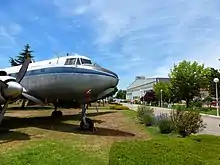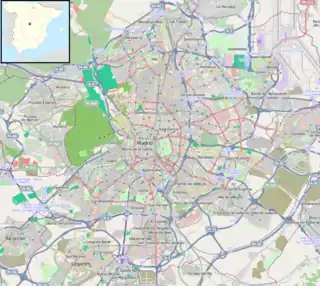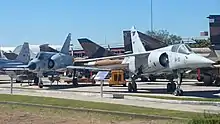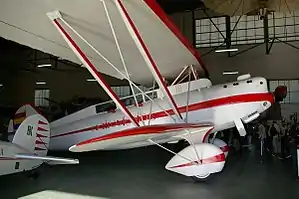Museum of Aeronautics and Astronautics (Madrid)
Museum of Aeronautics and Astronautics (in spanish: Museo de Aeronáutica y Astronáutica), also known as Air Museum (Museo del Aire), is an aviation museum located near of Madrid, is situated at Cuatro Vientos Air Base, Spain. The objective of the museum is to acquire, conserve and display the aircraft, equipment and associated paraphernalia that constitute the historical heritage of the Spanish Air Force. It has an exterior exhibition and seven hangars.
 | |
 Location within Madrid | |
Former name | Air Museum |
|---|---|
| Established | 16 June 1966 |
| Location | Madrid |
| Coordinates | |
| Type | Aviation museum |
| Owner | Spanish Air Force |
| Public transit access | Cuatro Vientos (Madrid Metro) |
| Website | official web |
History
In 1939 the Spanish Civil War came to an end and the Spanish Air Force was created. It is in this period the Ministry of the Air (Ministerio del Aire) appointed Colonel Társilo Ugarte Fernández to prepare a project for the creation of an aeronautic museum. However, 27 years passed before its creation. A first draft was presented in December 1948, with its location in the plant below the new building of the Ministry of the Air.
Through subsequent studies and consults, the Museum of Aeronautics and Astronautics was created by decree number 1437 of June 16, 1966, accountable to the Ministry of the Air and with headquarters in Madrid.
Since 1975, the museum has been based at Cuatro Vientos near of Madrid, however the works itself started at the end of 1979. Thereafter, it has been extended many times. Cuatro Vientos, was inaugurated in 1911 and is Spain's first military airfield. The airfield, although surrounded by construction, is still in use. The museum was officially inaugurated on 24 May 1981, by Lieutenant-General Emiliano Alfaro Jose Arregui.
In 1993, two new hangars were added, and even two more in 2002. Among these hangars, there is number 4, which was inaugurated on 22 August 2003, and which is dedicated to rotating wings and other autogyros, machines whose origins came directly from the spanish engineer Juan De La Cierva.
Museum Displays
The museum facilities extend over a surface of more than 66,938 m2 (720,510 sq ft), including outdoor displays, about 200 aircraft and seven hangars. There are mainly planes and helicopters, many of which have previously served in the Spanish Air Force. Visitors will also find hundreds of miniature aircraft models, engines, weapons, uniforms, vehicles, mock-ups and many other aviation related objects. Aircraft on display include a Vilanova Acedo, Spanish version of the Blériot XI built in 1911, the Jesús del Gran Poder, a special version of the Breguet 19 used on the transatlantic flight to Asia and America between 1928 and 1929, a few aircraft of the Spanish Republican Air Force, as well as the famous de Havilland Dragon Rapide used by Francisco Franco from the Canary Islands to Tétouan at the start of the military rebellion which began the Spanish Civil War in 1936.[1]

Outdoor exhibition area
The Spanish versions of the Heinkel He 111 and the Junkers Ju 52, fighters as McDonnell Douglas F-4C Phantom II or Mirage F-1, one Canadair Cl-215, Aerospatiale AS-330 Puma or even a MiG-17.
Hangar expositions
- Hangar 1: Beginnings of the history of aviation in Spain, aviation during the Rif War, Spanish aviation in the pioneer era and aircraft during Spanish Civil War.
- Hangar 2: Engines, simulators, aeronautical equipment and uniforms.
- Hangar 3: Training planes, fighters of the Spanish war, post-war fighters, gliders and a collection of propellers and engines.
- Hangar 4: Helicopters and autogyros with, among others, two La Cierva, or the Aerotécnica AC-12 and AC-14, and collection of flight instruments.
- Hangar 5: Spanish Air Force aircraft, like the General Franco's de Havilland Dragon Rapide, two versions of the local jet Hispano HA-200.
- Hangar 6: Dedicated mainly to restoration.
- Hangar 7: A collection of more than 100 models on a 1:10 scale
Aircraft exhibits
List of selected aircraft on display
| Designation | Displayed identity | Notes | Image |
|---|---|---|---|
| Aerotécnica AC-12 | Z.2–6 | commons | |
| Aerotécnica AC-14 | Z.4-06 | commons | |
| Boeing KC-97G | TK.1-03 | '123-03' | |
| Bolkow Bo.105LOH | HR.15–21 | 'ET-140' | commons |
| Breguet 19GR | - | 'Cuatro Vientos' | commons |
| Breguet 19TR Bidon | 72 | 'Jesus del Gran Poder' | commons |
| Bristol F.2B | B21 | ||
| CASA 2.111E (Heinkel 111H) | T.8B-97 | '462-04' | |
| CASA 352L (Junkers Ju 52) | T.2B-211 | '911-16' | commons |
| CASA C-101 Aviojet | XE.25-01 | commons | |
| CASA C-207 Azor | T.7-6 | '405-15' | commons |
| CASA C-212 Aviocar | XT.12-1 | '54-10' | commons |
| Caudron G.3 | BC-6 | commons | |
| Cierva C.6 | C.6-B | commons | |
| Cierva C.19 | EC-AIM | commons | |
| Cierva C.30A | XVU.1-1 | ||
| Consolidated PBY-5A Catalina | DR.1-1 | ||
| de Havilland Dragon Rapide | G-ACYR | Aircraft carried General Francisco Franco in July 1936 to Spanish Morocco at the beginning of the Spanish Civil War. | commons |
| de Havilland Canada DHC-4 Caribou | T.9–25 | commons | |
| Dornier Do 24T-3 | HD.5-2 | '58-2' | commons |
| Douglas C-47 Dakota | T.3–36 | '721-9' | |
| Farman F.402 | SF-002 | commons | |
| Fieseler Fi 156 Storch | L.16–23 | commons | |
| Grumman HU-16B | AD.1B-8 | ||
| Heinkel 111E-3 | B.2–82 | '25–82' | |
| Hispano HS-34 | EC-AFJ | ||
| Hispano HA-1112K1L Tripala | C.4J-2 | commons | |
| Hispano HA-1112M1L Buchon | C.4K-158 | commons | |
| Hispano HA-200 Saeta | A.10C-104 | commons | |
| Lockheed F-104G Starfighter | C.8–15 | '104-15' | commons |
| McDonnell F-4C Phantom II | C.12–37 | '12–29' | commons |
| Mikoyan-Gurevich MiG-17 | 42 | commons | |
| Mikoyan-Gurevich MiG-21 | 22–26 | E German AF | commons |
| Mil Mi-2 | CCCP-23760 | Icona '34' | commons |
| Nieuport IV | M.N.N.5 | ||
| North American T-6G | E.16–90 | '793-6' | commons |
| North American B-25J Mitchell | 130338 | '74-17' | |
| North American F-86 Sabre | C.5-175 | '1–175' | commons |
| Polikarpov I-15 | CA-125 | commons | |
| Slingsby T.34 Sky | EC-RAT | ||
| Transavia PL-12 Airtruk | VH-TRQ | commons | |
| Vilanova Acedo (Blériot XI) | - | commons | |
| Westland Whirlwind 2 | ZD.1B-22 | '803-4' | commons |
Gallery
 Hangar 2
Hangar 2.jpg.webp) Rocket Capricornio, Spanish satellite launch vehicle.
Rocket Capricornio, Spanish satellite launch vehicle..jpg.webp) Cabins from Douglas DC-9 and Boing 727
Cabins from Douglas DC-9 and Boing 727.jpg.webp) The Vilanova Acedo built in 1911, is the oldest aircraft preserved in Spain.
The Vilanova Acedo built in 1911, is the oldest aircraft preserved in Spain. Uniform from Condor Legion
Uniform from Condor Legion
 Hangar 5
Hangar 5 Jesús del Gran Poder, historical Spanish aircraft.
Jesús del Gran Poder, historical Spanish aircraft.
Visitors
- Timetable: Tuesday to Sunday: 10 am to 2 pm. The museum is closed to the public on all Mondays and special days (like public holidays), as well as the entire month of August.
- Visitors must follow the instructions of security personnel and museum staff at all times
- In the case of photographs or filming for personal use, it is not necessary to request any type of authorization.
- Visitors must show their entrance ticket whenever they are requested to do so by security personnel or museum staff, and they must retain said ticket until the end of their visit.
- The museum is a no smoking zone and smoking is prohibited.
- It is forbidden to touch the equipment on display
Ways to get there
There is no access from the airport to the museum, and this is surrounded by a confusing number of roads.
- By bus: It is better to take any of the Madrid-Alcorcón-Móstoles green buses of the BLAS company at Príncipe Pío station. These go along the Autovía A-5 and there is a stop near the museum: ask the driver where to drop off. Busses pass here frequently.
- Nearest metro and commuter rail station: Line 10 (Madrid Metro). Cuatro Vientos Metro station is a bit far from the museum, about 1 kilometre, but there is no marked or paved path to the museum. Walking beside the highly frequented highway is not very pleasant. It is advisable to take a taxi at Cuatro Vientos Metro station to the museum, which is actually part of an airforce base.
- By car: autovía A-5, 10,5 km. Parking is free in front of entrance to the Museum.
See also
- List of aircraft of the Spanish Air Force
- List of aerospace museums
References
- Alpert, Michael BBC History Magazine April 2002
Bibliography
- Guía del Museo de Aeronáutica y Astronáutica (in Spanish). Madrid: Ministry of Defence (Spain). 2014. ISBN 9788497818810.
- Ogden, Bob. (2009). Aviation Museums and Collections of Mainland Europe. Air-Britain (Historians) Ltd ISBN 0-85130-375-7
External links
| Wikimedia Commons has media related to Museo de Aeronáutica y Astronáutica de España. |
- Museo del Aire, the official website (2019)
- Asociación Amigos del Museo del Aire, Spanish association (2011) (in Spanish)
- Visit to Museo de Aeronáutica y Astronáutica (2009)
- aviationmuseum.eu: Museo del Aire (2010)
